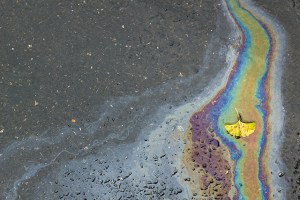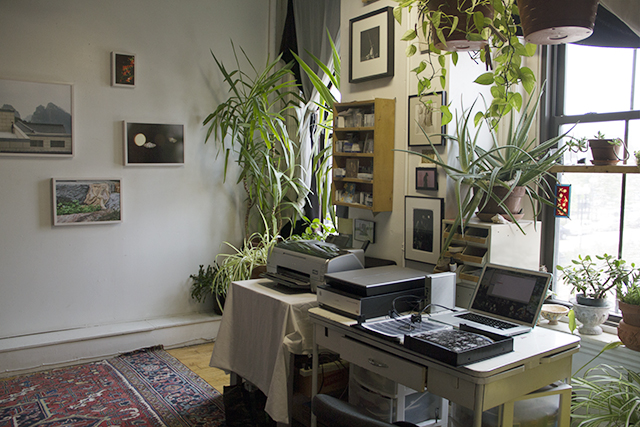
“Subway Sleeper 1”, from the series Subway Sleepers, Beijing
8″x10″ Tintype (photograph on blackened aluminum)
2014
Briefly describe the work you do.
I make photographs, videos, films and interactive installations. The content of my recent work is focused on the uncomfortable co-existence of the natural world with the man-made world in experimental short HD videos, large color photographs and multi-channel video installations. For many years, my work has been about shifting, changing and contradictory relationships (societal, familial, sexual, environmental), as well as the relationship we have with the gaze of the camera.
Tell us a little about your background and how that influences you as an artist.
When I was four years old, my dad gave me a Polaroid camera and I think this was instrumental in making me see the world photographically. By high school, I was hooked on the darkroom and have carried a camera with me every day since. In college, I was introduced to Art History and fell in love with the historic processes of Photography. For many years after college, I made most of my work in the darkroom with Alternative Processes – Tintypes, Palladium Prints, Cyanotypes, and hand-coated silver gelatin watercolor paper. I like the hands-on feeling of making a print with these processes, probably because I had been using my hands to make all types of art since I was young.
I became interested in experimental film because of the possibilities of working with time as an element in the work, slowly unfolding meaning over the duration of the experience. I started with super8, enjoying of the tactile feeling of the grain. Eventually I moved to video, which introduced me to digital editing and opened up the options of working with technology and new media.
Another big influence has been live music. The desire to create a similar experience in my work pushed me to make pieces that encourage or require viewer interaction and use the passage of time for transformation.
I have also traveled quite a bit, and visiting other cultures has been a huge influence in my work.
The concept of the “artist studio” has a broad range of meanings, especially in contemporary practice. The idea of the artist toiling away alone in a room may not necessarily reflect what many artists do from day to day anymore. Describe your studio practice and how it differs from (or is the same as) traditional notions of “being in the studio.”
My studio practice varies based on where I am working. When I am in my studio I am usually on the computer, editing, printing, emailing, and researching. But when I am out in the world I am shooting. I always have at least one camera with me, and now with the iPhone, I have at least two. These are my sketchbooks, journals, and tools to make new images. Because of the nature of my work, I can travel with a camera, laptop and hard drive and set-up a studio anywhere. But being in my own space, not a café or friend’s place, is important for focus for any length of time.

Installation View, “The Loveliest Mountain of China”, 3-channel 50-minute looping HD video with sound, three 42″ wall-mounted HD monitors, two wall-mounted horn speakers 2014
What unique roles do you see yourself as the artist playing that you may not have envisioned yourself in when you first started making art?
My work increasingly looks outside of myself, rather than inside, for content. I have always been drawn to universal themes, but historically from a personal viewpoint. These days I see the world in a larger context and I am interested in discussing bigger subjects like the environment, the nature of man and the exploration of perception.I believe that art can create emotional engagement with difficult subjects beyond academic discourse, scientific research and news reports. I aim to create a metaphysical experience with my work and visual beauty is an important element for me to draw the viewer in and guide the journey.
When do you find is the best time of day to make art? Do you have time set aside every day, every week or do you just work whenever you can?
I work all the time – shooting, editing, reading, writing, watching films – even when I am “playing” I am taking photographs. I never stop working, it is what I love to do.
How has your work changed in the last five years? How is it the same?
I work with more video and color digital photography now. I used to shoot all black and white film, now I rarely shoot film. As I mentioned earlier, my interests have shifted as well. I have always been and continue to be seduced by visual beauty and strive to communicate and create an experience for the visitor. I think my work feels very much the same (though more digitally produced), but it is stretching and pushing harder, while somewhat looser and more immediate.
Are there people such as family, friends, writers, philosophers or even pop icons that have had an impact on the work you do?
So many people and artists have influenced me. For example, artist and friend Fred Liang curated me into an exhibition at the Inside Out Art Museum in Beijing in 2012, where I stayed in residence most of the summer leading up to the show. This experience profoundly influenced all of my work since. My friend and teacher, filmmaker Saul Levine, taught me everything I love about film. Lots of other artists are a consistent inspiration and influence, though the names are constantly changing.
If you had an occupation outside of being an artist, what would that be and why?
I have no idea, nothing else ever appealed to me. I remember trying to figure out “what I want to be when I grow-up” and I could never come up with an answer. I only knew what I did not want, so I stayed away from the office route and kept wandering with my cameras.
About
 Lana Z Caplan is a photographer, video/filmmaker, curator and installation artist. Her work has been exhibited in galleries, museums, basements and backyards on four continents, including in solo and group exhibitions in cities such as Beijing, New York, San Francisco, San Juan, Edinburgh, Mexico City, Philadelphia, Boston, Manitoba, New Delhi, Tel Aviv, Valparaiso, and Barcelona. Her work has been widely reviewed online and in print, most recently in ARTnews (April 2014), and included in publications about New Media and Photography.
Lana Z Caplan is a photographer, video/filmmaker, curator and installation artist. Her work has been exhibited in galleries, museums, basements and backyards on four continents, including in solo and group exhibitions in cities such as Beijing, New York, San Francisco, San Juan, Edinburgh, Mexico City, Philadelphia, Boston, Manitoba, New Delhi, Tel Aviv, Valparaiso, and Barcelona. Her work has been widely reviewed online and in print, most recently in ARTnews (April 2014), and included in publications about New Media and Photography.
Caplan spent five years living in both Italy and the US, culminating with Sospira (2010), a 50-minute experimental documentary made with a production residency at theWexner Center for the Arts. In 2012, she spent the summer in Beijing making new video installations in residence at the Inside Out Art Museum for a show later that year. Traveling has a deep influence on her projects. She often creates site responsive pieces with a focus on human relationships as well as the relationships between humans and the natural or built environment.
Caplan has a BA from Boston University and MFA from Massachusetts College of Art and Design. She has worked as a curatorial assistant at Harvard University’s Fogg Art Museum and has been a member of the faculty of several colleges including Wellesley College, Simmons College and Massachusetts College of Art of Design.
All images copyright of the artist and used with their permission.


